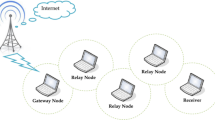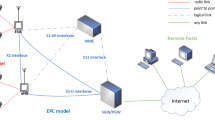Abstract
In the last few years, wide-area data services over North American digital (TDMA and CDMA) cellular networks have been standardized. The standards were developed under three primary constraints: (i) compatibility with existing land-line standards and systems, (ii) compatibility with existing cellular physical layer standards that are optimized for voice, and (iii) market demands for quick solutions. In particular, the IS-95 CDMA air interface standard permits multiplexing of primary traffic (e.g., voice or circuit data) and secondary traffic (e.g., packet data) or in-band signaling within the same physical layer burst. In this paper, we describe two radio link protocols for circuit-mode data over IS-95. The first protocol, Protocol S, relies on a single level of recovery and uses a flexible segmentation and recovery (FSAR) sublayer to efficiently pack data frames into multiplexed physical layer bursts. We next describe Protocol T, that consists of two levels of recovery. Protocol T has been standardized for CDMA circuit-mode data as IS-99 (Telecommunications Industry Association, 1994). We provide performance comparisons of the two protocols in terms of throughput, delay and recovery from fades. We find that the complexity of the two level recovery mechanism can buy higher throughput through the reduced retransmission data unit size. However, the choice of TCP (and its associated congestion control mechanism) as the upper layer of recovery on the link layer, leads to long fade recovery times for Protocol T. The two approaches also have significant differences with respect to procedures and performance at handoff and connection establishment.
Similar content being viewed by others
References
A. DeSimone and S. Nanda, Wireless data: Systems, standards, services, Wireless Networks 1 (1995) 241–253.
B.T. Doshi, R.P. Ejzak and S. Nanda, Radio link protocols for cellular data, in: Proc. Fifth WINLAB Workshop, April 26–27, 1995 (Kluwer Academic Publishers).
B.T. Doshi and P.K. Johri, Communication protocols for high speed packet networks, Computer Networks and ISDN Systems 24 (1992) 243–273.
S. Dravida, Tandeming of frame check sequences, unpublished work.
P. Karn, The qualcomm CDMA digital cellular system, ftp://ftp. qualcomm.com/pub/cdma.
S. Nanda, B.T. Doshi and R.P. Ejzak, A retransmission scheme for circuit mode data on wireless links, IEEE Journal on Selected Areas in Communications 12(8) (October 1994) 1338–1352.
R. Stevens, TCP/IP Illustrated (Addison-Wesley, 1994).
Telecommunications Industry Association, Base Station – Mobile Station Compatibility Standard for Dual-Mode Wideband Spread Spectrum Cellular System, IS-95.
Telecommunications Industry Association, Base Station – Mobile Station Compatibility Standard for Dual-Mode Wideband Spread Spectrum Cellular System, IS-95, Rev. B.
Telecommunications Industry Association, Data Services Option Standard for Wideband Spread Spectrum Digital Cellular System, IS-99, V&V Draft (September 1994).
Telecommunications Industry Association, TDMA Radio Interface: Radio Link Protocol 1, V&V Draft (August 1994). M.C. Chuah et al. / Link layer retransmission schemes 211
Author information
Authors and Affiliations
Rights and permissions
About this article
Cite this article
Chuah, M.C., Doshi, B., Dravida, S. et al. Link layer retransmission schemes for circuit-mode data over the CDMA physical channel. Mobile Networks and Applications 2, 195–211 (1997). https://doi.org/10.1023/A:1013680600129
Issue Date:
DOI: https://doi.org/10.1023/A:1013680600129




